 W
WAcantopsis dialuzona is a loach native to the swift, clear streams and rivers of mainland and archipelagic Southeast Asia, from India to Indonesia through the Chao Phraya and Mekong river basins. It can also be found in flooded fields.
 W
WAcrochordonichthys rugosus is a species of catfish of the family Akysidae. It inhabits clear, swiftly flowing forested streams of Thailand, Malaysia and Indonesia. A detailed discussion of this species's relationship with the other members of its genus can be found on Acrochordonichthys.
 W
WAkysis is the largest genus of catfishes of the family Akysidae.
 W
WThe Asian arowana comprises several phenotypic varieties of freshwater fish distributed geographically across Southeast Asia. While most consider the different varieties to belong to a single species, work by Pouyaud et al. (2003) differentiates these varieties into multiple species. They have several other common names, including Asian bonytongue, dragonfish, and a number of names specific to the different color varieties.
 W
WBagrichthys hypselopterus is a species of bagrid catfish found in Thailand, Indonesia and Malaysia. This species reaches a length of 40.0 cm and is commercially fished for human consumption.
 W
WThe bala shark, Balantiocheilos melanopterus, also known as the tricolor shark, tricolor sharkminnow, silver shark, or shark minnow, is a fish of the family Cyprinidae, and is one of the two species in the genus Balantiocheilos. This species is not a true shark, but is commonly so called because of its torpedo-shaped body and large fins.
 W
WBatrachocephalus mino, the beardless sea catfish, is the only species of catfish in the genus Batrachocephalus of the family Ariidae. This species occurs in marine and brackish waters of Bay of Bengal, and parts of the western central Pacific, in coastal waters, estuaries, and lower reaches of rivers. It is distributed from Pakistan, India, Sri Lanka, Bangladesh, Myanmar, Malaysia, Thailand, to Indonesia.
 W
WThe beardless barb is a species of freshwater fish in the family Cyprinidae. It is widespread in Southeast Asia. It grows to 25 cm (9.8 in) total length.
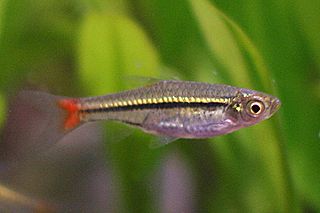 W
WThe blackline rasbora is a fish of the family Cyprinidae found in Asia in the Mekong, Chao Phraya, and Mae Klong basins, and also the northern Malay Peninsula. In the aquarium trade, it is known by a variety of other names, including red-tailed rasbora, bora bora rasbora, and brilliant rasbora.
 W
WBrilliant rasbora is a species of ray-finned fish in the genus Rasbora. They are found in the Malay Peninsula and in Borneo. Adults can grow up to 5 cm
 W
WChanna gachua, the dwarf snakehead, is a species of fish in the family Channidae. The name "dwarf snakehead" is also used for several other species of small snakeheads. C. gachua is native to freshwater habitats in southern Asia, where it has a wide distribution from Iran to Indonesia. This fish is considered to be a species complex, a group of several closely related taxa with one name. It is likely at least three to four different species, and further research may differentiate them. A few species such as Channa harcourtbutleri have been separated from the complex in recent decades. The easternmost population of C. gachua is often recognized as a separate species C. limbata, while the isolated Sri Lankan population often is recognized as C. kelaartii.
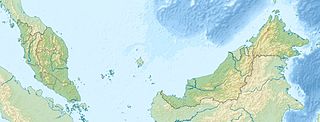 W
WClarias batu is a species of clariid catfish. It is only known from Tioman Island off the eastern coast of Peninsular Malaysia. The eel-like catfish found on this island were originally identified as the widespread species Clarias nieuhofii but comparison of a large series of specimens from Tioman with a series of C. nieuhofii from the mainland revealed consistent and distinctive differences indicating a separate species.
 W
WClarias nieuhofii, the slender walking catfish, is a species of clariid catfish. It has a wide distribution in Southeast Asia including southern Vietnam, Cambodia, Thailand, Malay Peninsula, parts of the Greater Sunda Islands, and the Philippines.
 W
WThe clown rasbora is a species of ray-finned fish in the genus Rasbora.
 W
WThe Malay combtail is a species of gourami native to southeast Asia where it is found in peat swamps of the Malay Peninsula and the Greater Sunda Islands. This species can reach a length of 20 centimetres (7.9 in) SL. It is a commercially important species and is also found in the aquarium trade. This species was formally described by Georges Cuvier in 1831 with the type locality of Java. The collector of the type was collected in 1820 by the Dutch physician and biologist Johan Coenraad van Hasselt (1797-1823), whom Cuvier honoured in its specific name, with his friend Heinrich Kuhl.
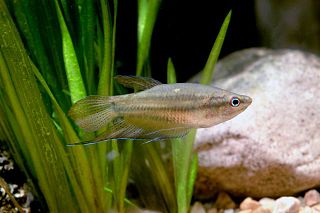 W
WThe croaking gourami is a species of small freshwater labyrinth fish of the gourami family. They are native to still waters in Southeast Asia and are distributed worldwide via the aquarium trade. Croaking gouramis are capable of producing a "croaking" noise using their pectoral fins.
 W
WDichotomyctere ocellatus, commonly the figure 8 puffer or eyespot puffer, is a pufferfish found in freshwater in Southeast Asia. It is known from the lower reaches of the Mekong (Cambodia), the Peninsular Malaysia as well as Borneo.
 W
WThe eyespot rasbora is a small fish belonging to the Family Cyprinidae, subfamily Danioninae, which is known by the common names of ocellated rasbora, hi-spot rasbora, and eye-spot rasbora, an allusion to the marking situated upon the dorsal fin. This small fish is a popular aquarium fish, having been one of the species featured in the landmark textbook Exotic Aquarium Fishes by Dr William T. Innes. Its appearance in this work only occurs in later editions of the book, however, therefore the species is not subject to the same degree of aquarium domestication as the more familiar harlequin rasbora.
 W
WThe giant pangasius, paroon shark, pangasid-catfish or Chao Phraya giant catfish is a species of freshwater fish in the shark catfish family (Pangasiidae) of order Siluriformes, found in the Chao Phraya and Mekong basins in Indochina. Its populations have declined drastically, mainly due to overfishing, and it is now considered Critically Endangered.
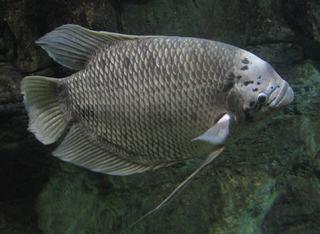 W
WThe giant gourami is a species of large gourami native to freshwater habitats in Southeast Asia, with its occurrence in other locations due to introductions. This species is commercially important as a food fish and is also farmed. It can also be found in the aquarium trade. The species has been used for weed control, also on highly invasive aquatic plants like Salvinia molesta, as the giant gourami can be a voracious herbivore.
 W
WGyrinocheilus aymonieri is a freshwater fish native to large parts of Southeast Asia. It is of interest as a local food source and for the aquarium trade. Its common names include honey sucker, sucking loach, Chinese algae eater, and Siamese algae eater; the FAO-endorsed common name is Siamese algae eater.
 W
WThe harlequin rasbora is a small fish in the family Cyprinidae. The species became an instant favorite among aquarists after its introduction in the early 1900s and is the best known and most widely kept species among the rasboras. In 1935, an image of a trio of harlequin rasboras, stamped in 14k gold, would grace the cover of the first edition of William T. Innes's classic Exotic Aquarium Fishes and would remain so through all 19 editions.
 W
WHemibagrus wyckioides, the Asian redtail catfish, is a species of catfish of the family Bagridae.
 W
WHyalobagrus ornatus is a species of bagrid catfish found in Indonesia, Malaysia and Thailand. It is found in the Muar River drainage in the southern Malay Peninsula of Malaysia and Thailand and Kapuas basin in western Borneo. It occurs in streams and peat swamps.
 W
WKottelatia brittani is a species of cyprinid fish that occurs in the Southeast Asian nations of Indonesia and Malaysia. It is the only species recognized in its genus.
 W
WKryptopterus cryptopterus is a species of catfish, the type species of the genus Kryptopterus. It can be distinguished from all its congeners, with the exception of the newly split Kryptopterus geminus, by the almost flat dorsal profile with no concavity behind the head. This species grows to a length of 14.6 centimetres (5.7 in) SL.
 W
WMalayochela maassi Is a species of cyprinid fish found in Indonesia, Malaysia and Brunei. It is the only member of its genus.
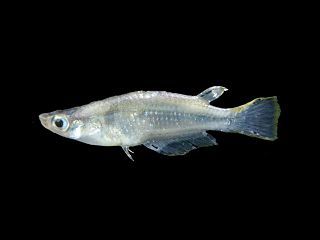 W
WOryzias javanicus, the Javanese ricefish, is a small species of fish in the family Adrianichthyidae. It lives in Peninsular Thailand, Malaysia, Singapore, and Indonesia, where it can be seen in both brackish and fresh water in ponds, ditches, mangrove, swamps, streams and canals.
 W
WOsteochilus melanopleura is a cyprinid freshwater fish from Southeast Asia. It inhabits rivers, swamps, and marshlands, and is adapted to impounded waters and seasonally flooded habitats. It is found in the Mekong River and Chao Phraya River and elsewhere in most countries in Indochina as well as in Sumatra and Borneo. It is eaten as a foodfish and is often processed into fermented products. It grows to 60 cm (24 in) SL.
 W
WOsteochilus microcephalus is a cyprinid freshwater fish from Southeast Asia.
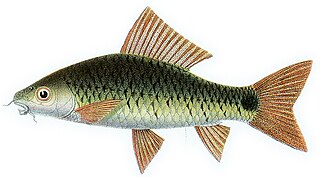 W
WOsteochilus spilurus is a cyprinid freshwater fish from Southeast Asia. It is found in Thailand, Peninsular Malaysia, Sumatra, Java, and Borneo. It grows to 7.5 cm (3.0 in) SL.
 W
WOsteochilus vittatus is a species of cyprinid fish from Southeast Asia. Its common name is bonylip barb, hard-lipped barb, or silver sharkminnow. It grows to 32 cm (13 in) SL.
 W
WOsteochilus waandersii is a cyprinid freshwater fish from Southeast Asia. It is found in Indochina as well as in Sumatra and Borneo. Its common name is Waanders's hard-lipped barb.
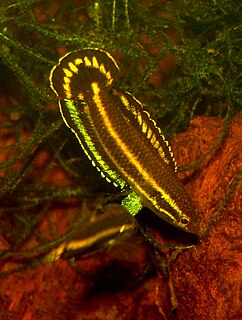 W
WParosphromenus harveyi is a species of gourami endemic to Malaysia, where it is only known from Selangor. The most extreme freshwater habitats in Peninsular Malaysia is the peat swamp forest that consist of dark-coloured and highly acidic waters. Parosphromenus harveyi is known as licorice gourami, small labyrinth fishes located within the north Selangor peat swamp forest from the Tanjong Malim area in neighbouring Perak state at least one population distribution that exhibit a wide variety of morphological and behavioural traits. Species of the osphronemid genus Parosphromenus that stenotypic inhabitant of peat swamp forests and associated black water streams which has a very little light penetrates. Parosphromenus was established by Brown, 1987. Since 1950s, the additional taxa have been described on a sporadic basis and there are 20 recognised members at present.
 W
WThe peaceful betta or crescent betta, Betta imbellis, is native to Southeast Asia, where it occurs naturally in Southern Thailand, Malaysia, and Indonesia, and has been introduced to Singapore. It is an inhabitant of stagnant waters in swamps, rice paddies, ditches, and pools. This species grows to a length of 6 cm (2.4 in). It is found in the aquarium trade.
 W
WThe Penang betta is a species of gourami native to Southeast Asia and common in swiftly flowing forest streams of the Malay Peninsula, Thailand, Sumatra, and the Riau Islands. In addition to its native range, the species has been introduced to Guam. It can be found amongst the vegetation growing along the banks. This species can reach a length of 6.7 centimetres (2.6 in) SL. It is one of the mouthbrooding Betta species. This species, as a natural predator of mosquito larvae, has found use in mosquito control efforts. Prior to its being eclipsed in Western public recognition by the mass-imported B. splendens, B. pugnax was well known as a fighting fish, as denoted by the specific epithet of pugnax, attracting the interest of scientists studying animal behaviour at least as long ago as the 1880s.
 W
WPhalacronotus apogon is a species of catfish of the genus Phalacronotus found in Southeast Asia. This species grows to a length of 130 centimetres (51 in) SL.
 W
WPhalacronotus bleekeri, commonly known as Bleeker's Sheatfish, is a species of catfish of the genus Phalacronotus. This species grows to a length of 60 centimetres (24 in) SL.
 W
WPuntigrus partipentazona, the partipentazona barb, is a species of cyprinid fish native to Southeast Asia where it is found in the Mekong, Mae Klong, and Chao Phraya basins of Thailand, the Malay Peninsula, and coastal streams of southeast Thailand and Cambodia where it occurs in streams and impoundments with dense weed growth. It can also be found in the aquarium trade. It is frequently misidentified as the similar Puntigrus tetrazona.
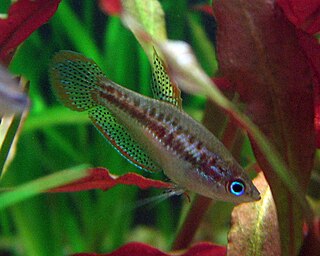 W
WThe pygmy gourami, also known as the sparkling gourami, is a freshwater species of gourami native to Southeast Asia.
 W
WRasbora trilineata is a species of ray-finned fish in the genus Rasbora. Common names include scissortail rasbora and three-lined rasbora. It comes from Southeast Asia.
 W
WRosefin rasbora is a species of ray-finned fish in the genus Rasbora from the Southeast Asia.
 W
WThe silver rasbora is a species of ray-finned fish in the genus Rasbora. It occurs in the Mekong, Chao Phraya and Mae Klong basins, Malay Peninsula as well as Borneo, Java and Sumatra.
 W
WThe smallscale archerfish is a perciform fish of genus Toxotes. As its name suggests, the scales of the smallscale archerfish are smaller than those of other archerfish. They reach a maximum length of 15 centimetres (5.9 in). Smallscale archerfish live in the tropical Indo-Pacific region and are potamodromous, moving between fresh and brackish water through their lifetimes.
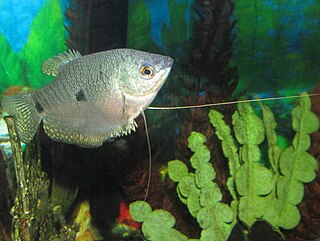 W
WThe three spot gourami, also known as the opaline gourami, blue gourami, and gold gourami, is a species of fish native to southeastern Asia, but also introduced elsewhere. This gourami gets its name from the two spots along each side of its body in line with the eye, considered the third spot. This species is of minor commercial importance as a food fish in its native range and is also farmed. It is also popular in the aquarium trade.
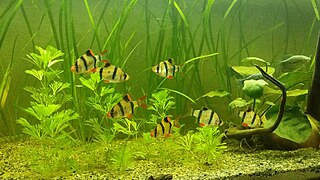 W
WThe tiger barb or Sumatra barb, is a species of tropical cyprinid fish. The natural geographic range reportedly extends throughout the Malay Peninsula, Sumatra and Borneo in Indonesia, with unsubstantiated sightings reported in Cambodia. Tiger barbs are also found in many other parts of Asia, and with little reliable collection data over long periods of time, definite conclusions about their natural geographic range versus established introductions are difficult. Tiger barbs may sometimes be confused with Puntigrus anchisporus, which are similar in appearance.
 W
WWallago attu is a freshwater catfish of the family Siluridae, native to South and Southeast Asia. It is commonly known as helicopter catfish or wallago catfish. Some regional designations, such as the Manipuri Sareng, the Bengal Boal, the Sylheti Gual or the Malaysian and Indonesian Tapah are also occasionally used in English. W. attu is found in large rivers and lakes in two geographically disconnected regions, with one population living over much of the Indian Subcontinent and the other in parts of Southeast Asia. The species can reach a total length of 1 m.